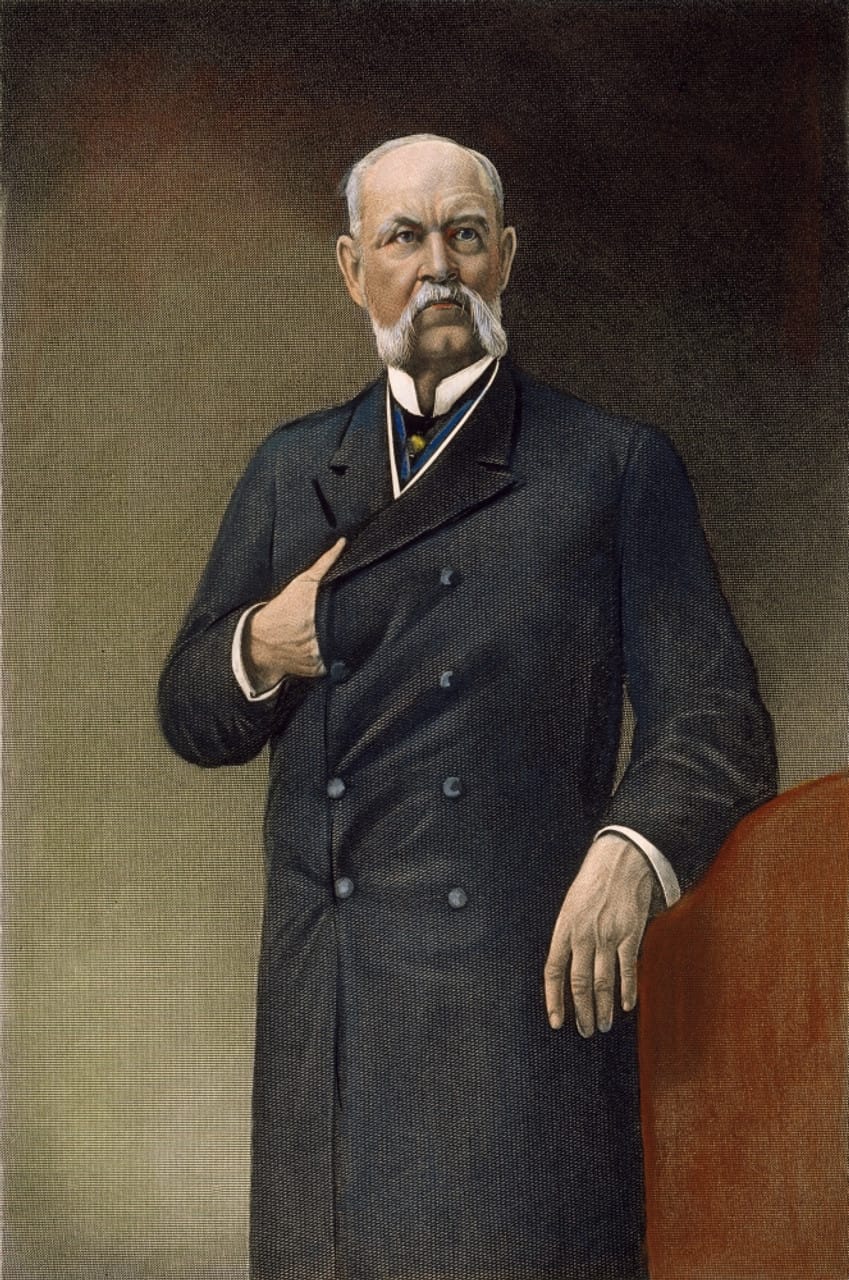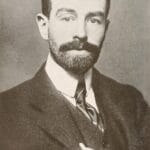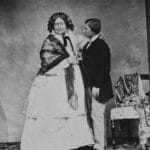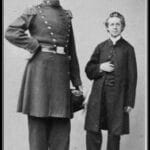Step into the dazzling, extravagant world of New York City during the Gilded Age. While names like Caroline Astor, his wife, dominated the headlines as the queen of high society, a quieter figure played a pivotal role: William Backhouse Astor Jr. Get ready to uncover the untold story of this enigmatic man—his passions, his aspirations, and the social conscience that shaped his life, leaving a legacy far beyond opulent parties and the glitter of the Gilded Age.
An Astor with a Passion for More
Born into the immensely wealthy Astor family, William Backhouse Astor Jr. could have easily coasted on his inherited fortune. While he certainly appreciated the luxurious lifestyle his family’s name afforded him, he was a man driven by his own passions and a desire to forge his own path.
One of those passions was horse racing. While not a traditional Astor family interest, William Jr. embraced it fully. He became a renowned horse owner, even boasting a Kentucky Derby champion amongst his stable. This victory, against the backdrop of a life already filled with success, suggests a man who thrived on competition and the thrill of pursuing his interests.
Beyond the racetrack, William Jr. poured his heart into Ferncliff, his magnificent estate. More than just a country retreat, Ferncliff became his canvas. He combined his love for architecture, gardening, and design, transforming the estate into a reflection of his own unique vision.
But William Jr.’s story isn’t just one of self-indulgence. When the Civil War erupted, his strong abolitionist beliefs spurred him to action. He financed an entire regiment for the Union Army—a testament to his commitment that went far beyond simple words.
And then there was “The Ambassadress”— his awe-inspiring yacht. This wasn’t merely a boat; it was the largest private yacht in the world, a floating palace that became the place to be seen during the Gilded Age. “The Ambassadress” served as both a symbol of Astor’s wealth and his desire to make a statement.
William Backhouse Astor Jr. might have been born into exceptional wealth, but he carved his own path. He was a trendsetter, a philanthropist, and some might even say, a bon vivant. His story reminds us that even in the extravagant world of the Gilded Age, individuals could—and did—seek to leave their own distinct mark on the world.
William’s Enduring Legacy
Born in 1829, William Backhouse Astor Jr. became a prominent figure during the Gilded Age. But unlike some who inherited vast fortunes, Astor Jr. possessed a multifaceted personality with interests ranging from the excitement of horse racing to the refined world of art collecting. He had a keen mind for business and became a major player in the burgeoning real estate scene of New York City.
Despite his privileged upbringing, Astor Jr. felt strongly about social issues. He vehemently opposed slavery and backed his convictions by financially supporting the Union Army during the Civil War, going so far as to fund an entire regiment.
Perhaps his most lasting contribution to the city is Astor Row, a collection of brownstone houses he built in Harlem during the 1880s. His vision was to create dignified, affordable housing for working families. Incredibly, these houses still stand today, serving as a physical reminder of Astor Jr.’s dedication to a more equitable city.
Of course, no account of William Jr. would be complete without mentioning his wife, Caroline Schermerhorn Astor. As members of the exclusive “Four Hundred,” the elite of New York society, they were the power couple of their era. Their lavish parties at their grand Fifth Avenue mansion became legendary, attracting the city’s most influential figures.
Tragically, Astor Jr.’s life was cut short in 1892 when he died unexpectedly from an aneurysm at the age of 62. He was laid to rest in Trinity Church Cemetery in New York City, a final resting place befitting his stature. Although his life may have been shorter than many anticipated, William Backhouse Astor Jr.’s legacy—a generous philanthropist, a shrewd real estate developer, and a prominent socialite—continues to resonate in the streets of New York City today.
Who Inherited the Astor Fortune?
John Jacob Astor’s wealth, a sum that would be worth billions today, went primarily to his son, William Backhouse Astor. William, already a successful businessman, used this inheritance to strengthen the Astor family’s control over New York City real estate, ultimately shaping the city we know today.
However, the Astor fortune didn’t end there. It was passed down through the generations, eventually reaching John Jacob Astor IV, William’s grandson. Tragically, this Astor met an untimely end aboard the Titanic. His death resulted in numerous, highly publicized legal battles over his will, demonstrating that great wealth can often lead to great legal complexities.
The Secrets Behind the Astor Family’s Wealth
The Astor family’s journey from modest beginnings to extraordinary wealth involved a combination of shrewd business decisions, timely investments, and a keen understanding of where to invest their money.
Their story begins with John Jacob Astor, the family patriarch. In the early 1800s, he recognized a lucrative opportunity in the fur trade. Beaver pelts were in high demand, and he established the American Fur Company, which formed the foundation of the Astor fortune.
His son, William Backhouse Astor, understood that land, particularly in a rapidly growing city like New York, was incredibly valuable. He began acquiring vast tracts of Manhattan real estate just as the city was expanding—an example of perfect timing.
But the Astors weren’t simply lucky; they were strategic. Instead of selling their properties for immediate profit, they held onto them, securing a consistent stream of income through rentals.
Recognizing the importance of diversification, the Astors also ventured into other industries, investing in railroads, insurance, and even the burgeoning steamship industry. They were always looking for the next big opportunity.
Their reputation played a significant role in their success as well. The Astors were known for their generosity, supporting institutions like the Astor Library and the Metropolitan Museum of Art. This not only enhanced their public image but also helped them cultivate relationships with influential individuals.
In essence, the Astor family’s wealth is a testament to hard work, smart decision-making, a bit of luck, and the understanding that helping others can often be the most profitable endeavor.
How Did William Astor Build His Fortune?
William Backhouse Astor Jr. was born into a life of privilege. His grandfather, John Jacob Astor, made a fortune in the fur trade, capitalizing on the high demand for beaver pelts. However, John Jacob possessed a shrewd business sense and knew trends could change quickly. He wisely invested his fur trade profits into Manhattan real estate. At the time, Manhattan was still developing, but John Jacob recognized its potential, and this foresight laid the groundwork for the Astor family to become one of the wealthiest families in American history.
William’s father, William Backhouse Astor Sr., continued to build upon the family’s success. He shared his father’s business acumen, making smart investments and increasing the family fortune to an astounding half a million dollars by 1848—a staggering amount for that time.
When William Jr. inherited his father’s wealth, he didn’t simply sit on it. He felt the weight of the Astor legacy and rose to the challenge. Like his father and grandfather before him, William Jr. invested in the booming real estate market. He capitalized on Manhattan’s growth, identifying and acquiring land in neighborhoods that were ripe for development.
However, William Jr. had a different strategy than his forefathers: long-term leases. Instead of selling properties for a quick profit, he leased them, creating a constant flow of income for the Astor family that would last for generations. It was a classic case of “buy low, rent high,” and this strategy proved incredibly successful for the Astor dynasty.
Key Takeaways:
- The Astor family’s wealth stemmed from being in the right place at the right time with the right ideas—first fur, then Manhattan real estate.
- William Backhouse Astor Jr. inherited a fortune most could only dream of.
- Instead of becoming complacent, he doubled down on real estate, focusing on long-term leases to create a real estate empire that would stand the test of time.
Learn more about other fascinating figures and historical events:
- Clyde Barrow
- Gustavus Adolphus and Christian Groups
- Stephen Hawking’s Contributions to Science
- The Rutherford B Hayes $1 Coin
- The Rise of Henry of Bolingbroke
- Haudenosaunee: The Good Mind
- The Machiavellian Way of Life
- The Life of Helen Herron Taft
Key Points:
- William Backhouse Astor Jr., born into extreme wealth, pursued his own interests and passions.
- An avid horse racing enthusiast, he owned several winning horses, including a Kentucky Derby champion.
- He channeled his artistic talents into Ferncliff, his grand estate, transforming it into a personal masterpiece.
- Astor Jr. put his money where his mouth was when it came to his abolitionist beliefs, financing a Union Army regiment during the Civil War.
- He owned “The Ambassadress,” the world’s largest private yacht, which became a glamorous gathering place for high society during the Gilded Age.
- Though born into wealth, Astor Jr. blazed his own trail, becoming a philanthropist, a trendsetter, and a man driven by his passions.
- Georgia Platform: A Southern Strategy, 1850s - March 31, 2025
- How many weeks is 40 days: Quick Conversion Guide for Accurate Results - March 31, 2025
- How many feet is 300 meters? 984 Feet: Understand Length Conversions Easily - March 31, 2025
















